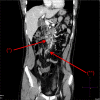Abdominal Kikuchi-Fujimoto lymphadenopathy: an uncommon presentation of a rare disease
- PMID: 35210223
- PMCID: PMC8883202
- DOI: 10.1136/bcr-2021-244732
Abdominal Kikuchi-Fujimoto lymphadenopathy: an uncommon presentation of a rare disease
Abstract
A 34-year-old man presented to our hospital with a 5-day history of progressive abdominal pain and fever. A CT scan identified extensive mesenteric lymphadenopathy. Initial diagnostic tests were inconclusive. Abdominal lymph node biopsy showed histiocytic necrotising lymphadenitis, compatible with Kikuchi-Fujimoto disease (KFD). This benign and self-limiting disease generally resolves following supportive treatment. In this case, remission occurred within 3 weeks of initial presentation. KFD is a very uncommon cause of lymphadenopathy, and selective mesenteric involvement is rare. Definitive diagnosis often requires lymph node biopsy. It is important to exclude more common and serious differential diagnoses associated with mesenteric lymphadenopathy, while maintaining a minimally invasive diagnostic approach, before progressing to nodal biopsy.
Keywords: haematology (incl blood transfusion); immunology; pathology.
© BMJ Publishing Group Limited 2022. No commercial re-use. See rights and permissions. Published by BMJ.
Conflict of interest statement
Competing interests: None declared.
Figures


References
Publication types
MeSH terms
LinkOut - more resources
Full Text Sources
